What Is The Best Trolling Rod For Walleye? (Top 6 Models Compared)
UPDATED 11 MAY 2023
by Robert Ceran
This article may contain affiliate links. If you make a purchase after clicking on a link we may earn a small commission at no extra cost to you.
Are you looking for a new walleye trolling rod, but not sure which model is right for you?
My team and I tested the most popular trolling rods for walleye on the market, and evaluated them based on their power, ability to perform well with flat lining or planer boards, and overall performance.
Based on our testing, here are our picks for the best walleye trolling rods in 2023:
- Best overall: Lew’s Speed Stick Planer Board Trolling
- Best budget option: Daiwa Accudepth Trolling
- Best lightweight: Mr Walleye Series Telescopic Trolling
- Best combo: Okuma Great Lakes Trolling Combo
- Best short option: Lew’s Speed Stick Flat Line Trolling
- Best long option: Temple Fork Outfitters Pro Walleye Trolling
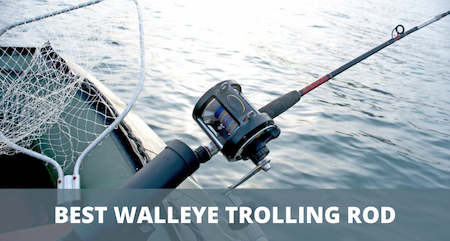
Best walleye trolling rod 2023 reviewed
The table above compares the most important specs of the top 6 models that we tested, and gives a recommendation for what each one of them is ideally suited for.
Now let’s dive into the details, and take a closer look look at each of these rods.
1. Lew’s Speed Stick Planer Board Trolling Rod
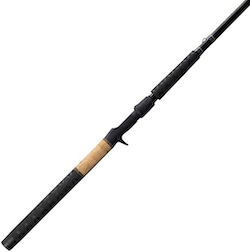

The Lew’s Speed Stick Planer Board rod was specifically designed for walleye fishing with planer boards, and comes with an impressive array of features that make it a great choice for this purpose.
During our testing we found that its length of 8’6” is ideal, since that length allows you to keep the line between the rod tip and the planer board above the water, which is very important, but hard to achieve with a shorter rod length.
In addition, the rod handle comes with a shrink tubing grip, and our tests showed that this makes it much easier to pull out of the rod holder.
This is a nice feature when you get a bite, and need to react as fast as possible to reel in the fish.
While most trolling rods are traditionally built with fiberglass, this model is a great example of a graphite rod that works extremely well for this purpose, due to the carbon strengthening technologies that have been developed over recent years, resulting in graphite rods that are just as durable and powerful as fiberglass models.

Features:
- Premium IM8 graphite blank
- Custom Lew’s reel seat
- Fuji guides with aluminum oxide inserts
- Shrink tubing grip for easy removal from rod holder
2. Daiwa Accudepth Trolling Rod
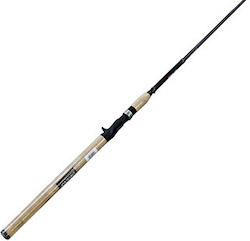

Unlike the Lew’s model, which is built with a pure graphite blank, the Daiwa Accudepth is built with a graphite/fiberglass composite blank, which makes it more durable, and gives it a more flexible parabolic action.
Composite blank construction is also much cheaper than pure graphite, which explains why the Daiwa Accudepth retails at less than $50, making it our choice of the best budget walleye trolling rod.
Another great feature of the Accudepth is that it is a telescopic rod, which makes it more compact and easier to transport when you’re not on the water.
Since you don’t need to cast with this type of rod, you don’t need the same kind of accuracy in the rod taper, which means that telescopic rods perform just as well as two-piece or three-piece rods.
This rod pairs well with a Daiwa Accudepth line counter reel, which makes it a perfect choice for presenting lures at specific depths using a lure depth chart.

Features:
- Durable graphite/fiberglass composite blank
- Guides with aluminum oxide inserts
- Handle with air foam grips
3. Mr Walleye Series Trolling Telescopic Rod
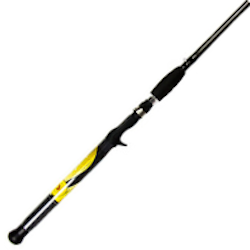

The Mr Walleye Series is another rod that was specifically designed for walleye trolling, and comes with all the right specifications for the job.
Based on our testing, we found that with a length of 8’6” it’s long enough to perform well with planer boards, while its graphite build makes it lightweight enough to enjoy fighting a walleye.
The most distinguishing feature of this model is its lightness of weight, and slender design, which is more reminiscent of a finesse rod.
This lightweight design is achieved with high modulus IM8 graphite, which is reinforced with strengthening technology to make it highly durable, and able to withstand the punishment of this kind of fishing.
If you’re used to heavy and sluggish glass fiber rods, then this model is a very pleasant surprise, and makes catching fish a lot more fun.
And just like the Daiwa Accudepth, this is a telescopic rod, making it very convenient to stow away and transport.

Features:
- High modulus IM8 graphite
- Semi-micro duraloc guides
- Split handle with shrink tubing grip
4. Okuma Great Lakes Trolling Combo
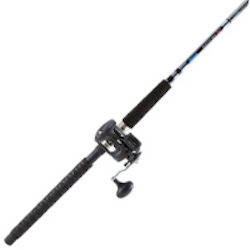

It’s impossible to do a review like this without including at least one Okuma rod. We chose the Okuma Great Lakes Combo since it comes with both a rod and a reel that have all the necessary qualities of a good walleye trolling rod and reel combo.
The rod has a length of 7’6”, and our testing revealed that is a great all around length that can be used for both flat lining and planer boards.
It was originally designed for down rigging, which gives it plenty of power to deal with the punishing environment of this kind of fishing.
The reel comes with two ball bearings and a line counter, which is essential for this kind of walleye fishing, as that allows you to adjust the depth of your lure.
We tested this walleye trolling combo by fishing for walleye on lake Erie, and caught suspended walleye all day long.

Features:
- Durable fiberglass blank
- Stainless steel guides with aluminum oxide inserts
- EVA foam grips
- Line counter reel with 2 ball bearings
5. Lew’s Speed Stick Flat Line Trolling Rod
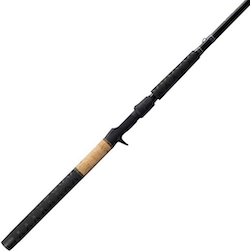

Unlike the other Lew’s Speed Stick model reviewed above, this model was specifically designed for flat line trolling (in other words, without using a planer board).
For this type of fishing it’s best to use either very short or very long rods, so you can spread out your lines.
We tested the 6’6” model for this review, since it combines well with any of the other rods that are long enough to use with planer boards.
If you’re also interested in the longer version of this rod, which is 10’6” (check current price on Amazon), you can use that as an outer rod combined with the shorter one on the inside, and run a spread of flat lines that way.
This style of trolling is easier and faster to set up, and a pure flat line setup is also easier to work with when it comes to changing direction with your boat.

Features:
- Premium IM8 graphite blank
- Custom Lew’s reel seat
- Fuji guides with aluminum oxide inserts
- Shrink tubing grip for easy removal from rod holder
6. Temple Fork Outfitters Pro Walleye Trolling Rod
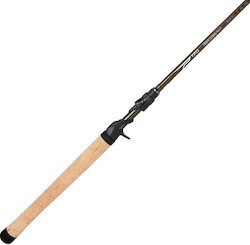

The TFO Pro rod was specifically designed for walleye fishing with planer boards, and comes with an impressive array of features that make it a great choice for this purpose.
Our testing showed that its length of 8’6” is ideal, since that length allows you to keep the line between the rod tip and the planer board above the water, which is very important, but hard to achieve with a shorter rod length.
In addition, the rod handle comes with a shrink tubing grip, and again, our testing confirmed that this makes it much easier to pull out of a rod holder.
This is a nice feature when you get a bite, and need to react as fast as possible to reel in the fish.
While most trolling rods are traditionally built with fiberglass, this model is a great example of a graphite rod that works extremely well for this purpose, due to the carbon strengthening technologies that have been developed over recent years, resulting in graphite rods that are just as durable and powerful as fiberglass models.

Features:
- Premium IM8 graphite blank
- Custom Lew’s reel seat
- Fuji guides with aluminum oxide inserts
- Shrink tubing grip for easy removal from rod holder
7. Okuma Classic Pro GLT
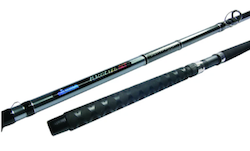

This is another rod that was developed by Okuma for great lakes fishing. It was originally designed for fishing with downriggers, but works equally well for walleye trolling tactics. It features a powerful and highly durable fiberglass blank construction.
In addition to its durable build, the Classic Pro GLT comes at an unbeatable price under $40.
When we put it to the test, we found that this rod is a great option if you are looking for a cheap way to get some extra rods in the boat so as to increase the number of lines in the water without breaking the bank.
Similar to the Lew’s model reviewed above, the butt section of the handle comes with a shrink tube rubber overlay, which makes it more convenient to remove from a rod holder.

Features:
- Durable fiberglass blank
- Stainless steel guides
- Rubberized shrink tube overlay on grip
What makes a good trolling rod for walleye?
When choosing a good trolling rod for walleye, our tests revealed that there are several key qualities you should look for, including the right build material, length, rod power, and rod action.
You should also make sure that your rod is compatible with a line counter reel (which all models reviewed in this article are).
Here are the ideal specifications you should look for:
Rod blank material
Traditionally, the blanks of trolling rods have been built with a fiberglass, since fiberglass is more durable and more flexible than graphite, which are exactly the right qualities you need for this kind of fishing.
Keep in mind that trolling poles need to take a lot of punishment from pulling big lures and sinkers over a great distance, dragging planer boards in rough water, and fighting big walleye.
That often means pulling in a planer board plus a big walleye at the same time, and you need sufficient rod backbone plus flexibility to handle that kind of load.
The great thing about fiberglass is that it’s almost impossible to break, which means you won’t get any unwelcome surprises while landing a trophy walleye.
Bu having said that, walleye don’t put up that much of a fight, which means that too much rod power can be overkill.
Because of this, many manufacturers have started building composite rods made of fiberglass combined with graphite, and even pure graphite rods for walleye trolling.
For an example of the latter, check out the Denali Myriad in this review, which is a great lightweight walleye rod.
Graphite strengthening technologies have gotten so good over the past decade that carbon rods are becoming almost as durable as glass fiber rods, while being much lighter.
This allows you to get a much better feel for the walleye while reeling it in, which can make it a more enjoyable experience for anglers who miss the sensitivity of lightweight walleye jigging rods, where you tend to get a much better feel for the walleyes.
Walleye trolling rod length
Choosing the right rod length for walleye trolling is essential, and depends on which setup you’re planning to use.
There are two basic setups for this kind of walleye fishing: flat line trolling, and trolling with planer boards.
Flat lining means that the line goes straight from your rod tip into the water, which is easier to set up, but doesn’t allow you to get a big spread between your lines if you’re using more than two rods at the same time.
If you’re planning to do flat line trolling, it’s best to have both some shorter rods around 5’ to 6’, as well as some longer rods around 8’ to 12’.
That way you can set up the outermost lines with the longest rods, and the innermost lines with the shortest rods, which gives you somewhat of a spread.
On the other hand, if you’re planning to use planer boards for trolling, you need to use rods that are at least 8’ long, since that enables you to keep the line between the planer board and the rod tip over the water surface (to avoid line friction dragging the planer board off course).
Finally, you can also combine the two methods at the same time, by using long rods with planer boards for your outermost lines, and short flat lining rods for your innermost lines, and this is in fact what many anglers choose to do.
Best rod power and rod action for walleye trolling
When it comes to power, it’s best to choose medium or medium heavy power rods.
This gives you enough rod backbone to deal with the strain of dragging planer boards through choppy water, and pulling in big walleye together with a planer board.
If you’re planning to do flat line trolling, you can go a little lighter, and choose a medium light rod power, which can give you a little bit more sensitivity in terms of being able to feel the walleye on the end of your tackle as you reel it in.
Finally, in terms of action, you should always look for moderate rod action in trolling poles, which allows the blank to bend down to the middle of the rod in a big parabolic bend.
This flexibility helps to cushion the load on your tackle from dragging planer boards and fighting big walleye
How to set up your walleye trolling rod
Once you’ve chosen your preferred model, you need to set your trolling rod up correctly.
Make sure to pair it with a line counter reel, which is a type of round spool baitcasting reel that comes with a line counter mechanism. This mechanism allows you to measure the amount of line you release from the spool.
You can refer to a lure depth chart to calculate the amount of line you need to release from your line counter reel in order for your lure to dive down to a specific depth range.
This is extremely useful for walleye trolling, since you can use a fish finder to identify the right depth to target, and then present your lure at that depth.
In addition, if you get a bite on one of your rods at a particular depth setting, you can then reproduce the same settings on all of your trolling poles if you’re using line counter reels.
The best line to use for this type of fishing is 10 to 15 lb test fluorocarbon, which you can tie directly to your lure.
What is the best trolling rod and reel combo for walleye?
For us there can be no doubt that the Okuma Great Lakes Combo is best walleye rod and reel combo for trolling.
With it’s length of 7’6″ it’s a great all around trolling rod that can be used either with planer boards, or for flat line trolling.
The fiberglass build makes it highly durable, while its line counter reel is essential for targeting the right depth consistently with your lure presentation.
Final remarks
This concludes our review – all of the rods are high quality models that will serve you well, and so the most important task is choosing the right length for your specific purpose.
Trolling is the single most effective way to catch walleye during the open water season, and tends to produce a lot more bites than any other walleye fishing tactic.
Methods and gear used for testing
For consistent testing results, we tested each rod under similar conditions by trolling on Lake Erie. We paired all of the rods with the same reel, a Okuma Convector line counter reel, spooled with 40 lb test Power Pro braid leading to a 12 lb test fluorocarbon leader. We tested each rod with both flat lining or with planer boards.






